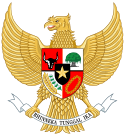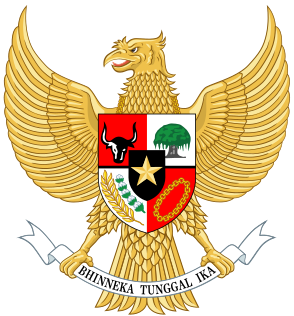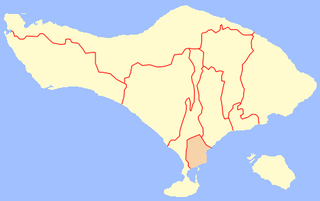
Denpasar is the capital of Bali and the main gateway to the island. The city is also a hub for other cities in the Lesser Sunda Islands.

Gianyar is a regency (kabupaten) in the Indonesian province and island of Bali, Indonesia. It has an area of 368 km2 and population of 470,380, making it the second most densely populated district in Bali. Its regency seat is Gianyar. The civil registry survey of April 2011 listed 480,447 people, of which 469,929 were classified as Hindu.

Tabanan is a regency (kabupaten) of Bali, Indonesia. It has an area of 839.33 km2 and population of 386,850 (2000), rising to 420,913 in 2010 Census. Its regency seat is Tabanan. Tanah Lot is in Tabanan.

The Klungkung Palace, officially Puri Agung Semarapura, is a historical building complex situated in Semarapura, the capital of the Klungkung Regency (kabupaten) on Bali, Indonesia. The palace (puri) was erected at the end of the 17th century, but largely destroyed during the Dutch colonial conquest in 1908. Today the basic remains of the palace are the court of justice, the Kertha Gosa Pavilion, and the main gate that bears the date Saka 1622. Within the old palace compound is also a floating pavilion, the Bale Kembang. The descendants of the rajas that once ruled Klungkung today live in Puri Agung, a residence to the west of the old palace, which was built after 1929.
Gelgel is a village (desa) that is situated in the regency (kabupaten) of Klungkung, on the Island of Bali, Indonesia. The village, which lies four kilometers south of the regency capital Semarapura, not far from the coast, contains a number of culturally interesting structures. It is known for its pottery and handwoven ceremonial songket cloth. The village mainly owes its fame to the kingdom of Gelgel, which dominated Bali from perhaps the early 16th century to 1686. There are no traces left today of the old royal palace (puri). The old ancestral shrine of the ruling dynasti, Pura Jero Agung, is still standing in the old palace area. To the east of Pura Jero Agung is another old temple, Pura Dasar, which is a lowland counterpart of the "mother temple" of Bali, Pura Besakih. The village also contains the oldest mosque of Bali, which was built by Javanese retainers of the old kings.

The Bali Museum is a museum of art and history located in Denpasar, Bali, Indonesia.

The Dutch intervention in Bali in 1906 was a Dutch military intervention in Bali as part of the Dutch colonial suppression, killing over 1,000 people, most of whom were civilians. It was part of the Dutch campaign for the suppression of most of the Netherlands East-Indies. The campaign killed the Balinese rulers of Badung and their wives and children, as well as destroying the southern Bali kingdoms of Badung and Tabanan and weakening the kingdom of Klungkung. It was the sixth Dutch military intervention in Bali.
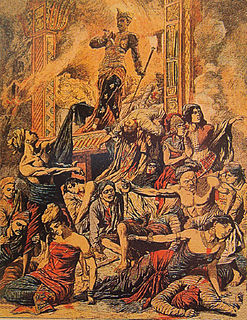
The Dutch intervention in Bali in 1849 was a major Dutch military intervention in Northern and Southern Bali, following two failed interventions, the 1846 intervention and the 1848 intervention. The Dutch used as a pretext Balinese salvage claims over shipwrecks, which were customary to the Balinese, but unacceptable under International law.
Balinese Kshatriya is a Hindu Kshatriya community which exists in the island of Bali in Indonesia. During the second half of the sixth century, Bali had a strong Kshatriya ruling dynasty. The rulers were mostly indigenous Balinese with some Indian blood. These clans mostly belonged to the Nāgavanshi dynasty. However, in due time, these indigenous Kshatriyas became extinct and were replaced by the Javanese Kshatriyas who immigrated to Bali. Most of the Kshatriyas now living in Bali are claimed to be the descendants of the King Dewa Agung, who immigrated to Bali from Java. However, there are also a few other Kshatriya clans who were elevated to the Kshatriya status from the Vaishya varna. All together, Kshatriyas constitute around 4% of the total Balinese Hindu population.
Kodam IX/Udayana is a military area command of the Indonesian Army which is responsible for the provinces of Bali, West Nusa Tenggara and East Nusa Tenggara. It was established as part of the 1985 reorganisation of the Indonesian National Armed Forces (TNI) and included East Timor until that province achieved independence in 1999.
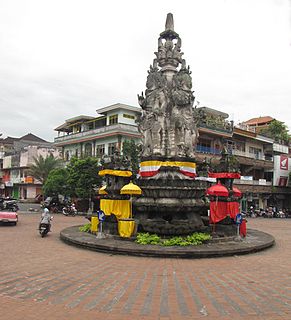
Semarapura is the capital city of the Klungkung Regency in Bali, Indonesia.
PS Bangli is a defunct Indonesian football club based in Bangli, Bali. They used to play in the top division in Indonesian football, the Liga Indonesia. Their home stadium is Kapten i Wayan Dipta Stadium. The club hit financial difficulties in 2005 and has decided to discontinue its run. This led to an opportunity for other clubs from Bali to merge and form a club using Perst Tabanan's license to compete in the Liga Indonesia. Local clubs such as Perseden Denpasar, Persekaba Badung and Persegi Gianyar merged with Persegi Gianyar to form a new club called Bali FC.

Trans Sarbagita is a bus rapid transit (BRT) system in Denpasar, Bali, Indonesia. The system began its operations on 18 August 2011. It was designed to rebuild Bali's public transport system. As of 2014, the buses carried 5,000 passengers per day with 25 Buses in operation. The buses run in 2 routes, the first is Batubulan - Nusa Dua vv and Denpasar Kota - Garuda Wisnu Kencana vv. The ticket prices are 3,500 IDR for adults and 2,500 IDR for students. in 2015 Trans Sarbagita launched two new routes, Tabanan-Mengwi-Bandara and Mahendradata-Sanur-Lebih.

The Kingdom of Bali was a series of Hindu-Buddhist kingdoms that once ruled some parts of the volcanic island of Bali, in Lesser Sunda Islands, Indonesia. With a history of native Balinese kingship spanning from the early 10th to early 20th centuries, Balinese kingdoms demonstrated sophisticated Balinese court culture where native elements of spirit and ancestral reverence combined with Hindu influences – adopted from India through ancient Java intermediary – flourished, enriched and shaped the Balinese culture.

The 1976 Bali earthquake occurred at 15:13 local time on 14 July with a surface wave magnitude of 6.5. The shock occurred 5 kilometres (3.1 mi) south of the Bali Sea coast of the Buleleng Regency, and about 65 kilometres (40 mi) northwest of Denpasar. Up to ninety percent of houses in Buleleng Regency were seriously damaged or destroyed and the Seririt sub-district was almost completely destroyed, where a school building collapsed and trapped at least 200 students. 573 people are believed to have died; at least 544 in Buleleng Regency, 24 in Jembrana and 5 in Tabanan. Four thousand more suffered injuries and an estimated 450,000 were left temporarily homeless.

I Gusti Bagus Oka was the Governor for the Province of Bali and Vice-Governor for the Province of Lesser Sunda. He and his wife, Gedong Bagus Oka, were the founding members of the Parisada Hindu Dharma Indonesia. I Gusti Bagus Oka was also the first Vice-chair of Parisada Hindu Dharma Indonesia. Throughout his public service career, I Gusti Bagus Oka held various government offices, while Gedong Bagus Oka served as Member of Parliament. The couple were also actively involved in social activity and founded Ashram Gandhi in Candidasa, Bali.
